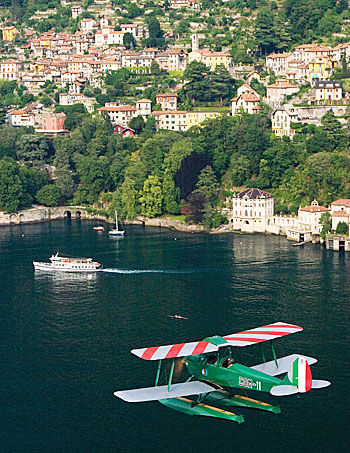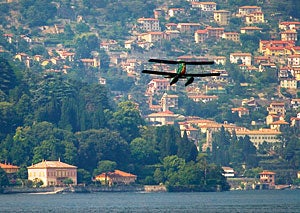Emerald Goddess
Saved from the scourges of war, a glorious Italian biplane rises from the ashes to lead la dolce vita
 |
Tall and dignified, moving with the easy gait of Marcello Mastroianni in a '60s Frederico Fellini movie, Gerolamo Gavazzi supervises the dock crew. They're winching down his Caproni seaplane from its lofty perch. Most days, it hangs suspended from the hangar rafters for all to see and admire at Aero Club Como, one of the most celebrated seaplane bases in the world.
Several hands guide the seabird on its wheeled cart down to the soothing blue-green waters of Lago di Como---northern Italy's lush playground, Lake Como. Gavazzi is a perfect match for the Caproncino, or "little Caproni." Fellini himself couldn't have cast this duo of plane and pilot any better. Signore pilota Gavazzi has the silver hair and dashing smile of an aristocrat or matinee idol. Likewise, the airplane, in its immaculate restoration, exudes a simple elegance from every polished brass fitting and every taut rigging line.
Indeed, this very airplane, along with its fellow Caproncini, once taught pre-World War II pilots the skill and art of float flying. Today, the little Caproni Ca100, built in 1935, is a celebrated showpiece at Aero Club Como. Every month, people come from near and far for Caproni Day just to see it fly.
It's a magnificent creature by any standard. Aesthetically, the biplane---a variant of the de Havilland Gipsy Moth first license-built by the Caproni factory in 1929---is a sterling evocation of the Golden Age of flight.
From a pilot's perspective, you want to clamp your hands onto the leather-collared open cockpit, climb in, pull on the helmet and goggles, throttle up the in-line Colombo S63 engine and send the lake's spray flying.
And historically, it's a rare gem indeed; it's the only Italian pre-World War II idrovolante, or seaplane, still flying today. But the story of its survival and resurrection is even more remarkable. Were it not for the devotion of certain anonymous aviation visionaries, by all rights, Caproni aircraft number MM65156/I-ABOU should have been covered in mud at the bottom of Lake Como for the last 61 years.
 The immaculately restored Caproni Ca100 is based at Aero Club Como, on the shores of northern Italy's Lake Como. |
In April of 1945, the German army occupying northern Italy was in hasty retreat before the onslaught of Allied forces. A squad of Wehrmacht soldiers came to Como, the lovely town at the lake's south end (where, incidently, the seaplane base has been in continuous operation since 1930). They commanded that every Caproncini be taken into the middle of the lake!and sunk.
But someone whose name is lost to history saw what was coming and took steps to avert the aviation tragedy. A single Caproni Ca100 escaped the watery burial. Secreted to the little town of Pavia, an ancient Roman city 20 miles south of nearby Milan, it survived the Allied invasion untouched. Lake Como wasn't so kind to Italian dictator Benito Mussolini. Days later, just a few miles to the north, Il Duce met his grisly fate. Hoping to escape his own citizens and the Allies, he disguised himself as a Nazi officer riding in a German convoy, but was captured in Dongo, a town on Lake Como's northwestern shores. Told by his captors that he was being rescued, Mussolini was instead unceremoniously stood up against a wall with his mistress and machine-gunned to death.
Many years later, a young accountant came to Lake Como with a dream---to learn to fly. It was the 1960s, a time of renaissance for Italian culture. Fellini had just released the wildly popular film, La Dolce Vita.
Excited to make his first flight, Gerolamo Gavazzi climbed into the dilapidated open cockpit of an old seaplane. In his logbook at the end of the day, he wrote down the registration number: MM65156/I-ABOU. His instructor told him it was one of very few Italian aircraft to escape destruction in World War II.
"I had met my first love," says Gavazzi today of that encounter. He would never forget the airplane. Gavazzi went on to earn his license, all the while remembering the plane. By 1968, however, the little Ca100 he left behind was worn out, and its airworthiness certificate was yanked.
The Ca100 that Gavazzi flew remains almost the only survivor of a large number of Ca100s built to train pilots from 1929 on. The Caproncino was the brainchild of Gianni Caproni, an Italian count and engineer who founded his aeronautics factory in 1909. Thousands of Caproni heavy bombers, advanced for the time, were built during World War I for the British, French and U.S. air corps.
The Caproni group became one of Italy's largest industrial enterprises during the inter-war years. Caproni aircraft filled the skies. The piston single-engine altitude record of 56,046 feet, set in 1938 by Italian pilot Mario Pezzi flying a Caproni 161bis, remains unbroken to this day.
The Ca100 biplane and seaplane were popular with the Italian military for its training missions, continuing in service until 1939. There were 14 at one time at Aero Club Como alone.
One day, many years after his introduction to the joys of aviation, Gavazzi happened upon an old biplane wreck. It was a Ca100, the same type he had learned to fly in. By now, he was a well-established accountant, running his own prosperous Studio Gavazzi firm in Milan. He looked into the cockpit and shook his head. Covered in dust and grime, it was a sad end for such a wonderful, reliable old bird.
He found the registration plate, wiped it off and read the numbers. A chill went up his back. He checked his logbook. It was the same airplane he had flown for the first time in the 1960s! Gavazzi bought it on the spot and vowed to bring her back to life, piece by piece.
"You know, it is crazy to do these things," he says, relaxing on the deck of Aero Club Como. "You must stay very much involved in every aspect of the restoration. It takes lots and lots of time. From the economic point of view, it's completely ridiculous! Maybe it ends up costing 10 times the market value. But," he says, flashing his dazzling smile, "it is the return of my first love."
And how can you put a price on that?
Over the next six years, Gavazzi put his heart, soul and a Roman treasure-barge's worth of money into the restoration. Today, the cool green biplane proudly shows the efforts of the restorer's art in its every nuance. The inter-war paint scheme is authentic and flawless. The engine, a Colombo S63 in-line six-cylinder 130 hp cranks right up.
"I found a company with an old employee who knew these engines very well," says Gavazzi. "It took a very long time, but he made one engine from the parts of three that he found." Gavazzi also located an old Caproni factory worker to help in similar fashion with the airframe rebuild.
Only two Caproni Ca100s remain in Italy: this one, which once again has its original airworthiness ticket, and a wheeled land version, also restored by Gavazzi!
Both are celebrated examples of classic airplanes and have won many awards. Perhaps the most prestigious of those awards is the Phoenix Diploma, bestowed by no less than the Federation Aeronautique Internationale, (FAI). The award is given for the best reconstruction or restoration of a vintage aircraft by an individual amateur.
Many years, the Phoenix Diploma isn't awarded at all. Gerolamo Gavazzi has won it twice (in 1991 and 2001). He's the only person to achieve such a feat.
It's a hot, humid day on Lake Como. Looking north through the haze over the lake, the thousands of terra-cotta villas, homes and apartments that cover the many hills and mountains shimmer in the heat. Thoughts of jumping off the dock for a refreshing dip are on the minds of more than one of the hardworking young crew members.
Gavazzi pulls on his khaki flight suit and finishes the preflight. You'd think an owner who spent so much time rebuilding his seabird---around 10,000 hours---would be anxious to hop into the cockpit and fly. Instead, he patiently checks fuel and oil as if he had all the time in the world.
"When you fly these types of airplanes, it is true flying," he says, gingerly stepping into the rear cockpit for our photo session. "The smell of the leather inside, the oil. It's not like anything else."
The crew hand-props the engine to life. With easy confidence, Gavazzi taxis the emerald goddess out onto the breeze-lapped waters, guided by Lake Como's float-marked "runway." He turns into the wind, eases the throttle forward. The Colombo S63 roars to life, and in moments, the beautiful flivver lifts off from its foamy wake to sail the skies above Lake Como.
Cruising across the idyllic Lago di Como backdrop, Gavazzi might as well be filming a scene in a Fellini film. His goggles are parked up on his leather-helmeted forehead, in favor of a pair of stylish aviator sunglasses. Left arm laid jauntily on the cockpit rim, he pulls an easy bank to circle once above George Clooney's waterside villa.
You can so easily imagine him dropping a bouquet of flowers over the side to a waving Clooney, then turning south to land for an afternoon luncheon with friends, kicked off with bread and a glass of fine red vino at a sidewalk café amidst the many peach-colored buildings of Como.
La dolce vita, indeed.

Subscribe to Our Newsletter
Get the latest Plane & Pilot Magazine stories delivered directly to your inbox





